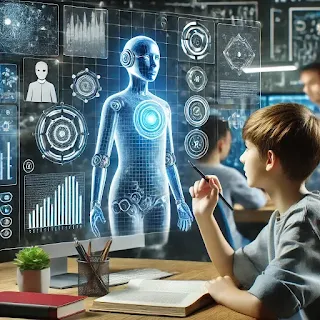Artificial Intelligence in Education: Personalized Learning and Beyond
- Get link
- X
- Other Apps
Artificial Intelligence in Education: Personalized Learning and Beyond
Introduction
Education is the cornerstone of progress, but the traditional one-size-fits-all approach has long been due for a transformation. With the advent of Artificial Intelligence (AI), this transformation is no longer a distant dream. From personalized learning paths to virtual classrooms, AI is revolutionizing how we teach and learn. In this article, we will explore how AI is reshaping education, focusing on personalized learning and its broader implications for the future of education.
The Rise of Personalized Learning
What Is Personalized Learning?
Personalized learning tailors educational content and methods to the unique needs, interests, and abilities of each student. Unlike conventional classrooms where all students follow the same curriculum, personalized learning adapts to individual learning speeds and styles, making education more effective and engaging.
 |
| Futuristic Classroom |
How AI Powers Personalized Learning
AI-driven platforms like Khan Academy, Duolingo, and DreamBox Learning use algorithms to assess students' strengths and weaknesses. These systems can:
Identify knowledge gaps and provide targeted lessons.
Offer real-time feedback.
Adjust the difficulty level of tasks based on student performance.
Benefits of Personalized Learning
Enhanced Engagement: Students receive material that matches their interests and abilities.
Improved Outcomes: Individualized attention leads to better understanding and retention.
Empowered Learners: Students can take control of their education, learning at their own pace.
AI in Smart Classrooms
Intelligent Tutoring Systems (ITS)
AI-powered tutors like Carnegie Learning or Squirrel AI are reshaping classrooms by offering:
Instant support for struggling students.
Interactive problem-solving activities.
Performance tracking to guide teachers in lesson planning.
Smart Classrooms in Action
Imagine a classroom equipped with smart boards, voice-activated assistants, and real-time performance analytics. AI ensures that every student receives attention, whether by alerting teachers to potential issues or automatically adjusting lessons to meet diverse needs.
Benefits for Teachers
Time-Saving Tools: Automating grading and administrative tasks allows teachers to focus on teaching.
Data-Driven Insights: AI helps educators identify trends and adjust their strategies accordingly.
Beyond Personalized Learning
Gamification of Education
AI is bringing the joy of gaming into classrooms. Platforms like Prodigy or Classcraft use AI to:
Turn lessons into engaging challenges.
Reward progress with virtual incentives.
Foster collaboration through team-based learning quests.
Virtual and Augmented Reality (VR/AR)
Combining AI with VR/AR creates immersive educational experiences. Imagine exploring the Great Wall of China from a classroom or conducting virtual science experiments. These technologies make learning:
Interactive and exciting.
Accessible for students who might otherwise lack resources.
Chatbots and Support Systems
AI-powered chatbots like IBM Watson provide instant support for students. Whether answering questions, guiding through assignments, or offering resources, these bots are available 24/7.
Challenges and Limitations
While AI offers immense potential, it is not without challenges:
Privacy Concerns: Collecting and storing student data raises ethical questions.
Equity Issues: Not all schools have access to the technology needed to implement AI-driven tools.
Over-Reliance on Technology: Excessive dependence on AI might limit human interaction, a crucial aspect of learning.
 |
| AI-Powered Virtual Tutor |
The Future of AI in Education
Lifelong Learning
AI-powered platforms can support continuous education by adapting to the evolving needs of learners, whether they are students, professionals, or hobbyists.
Global Accessibility
AI has the potential to democratize education by offering high-quality resources to underserved communities worldwide. Imagine a future where every child, regardless of location, has access to top-notch educators through AI.
Smarter Assessments
Traditional testing methods are often limited in scope. AI can evaluate students holistically, considering creativity, critical thinking, and emotional intelligence alongside academic performance.
Conclusion
Artificial Intelligence is not just a tool; it’s a revolution in education. By enabling personalized learning and introducing innovative teaching methods, AI is breaking barriers and creating opportunities for students and educators alike. However, it’s essential to address challenges like privacy and accessibility to ensure that AI serves as a force for good.
As we move forward, the integration of AI in education will continue to evolve, offering new ways to inspire and empower learners. The future of education is not just about technology but about using it to unlock human potential in ways we’ve only begun to imagine.




Comments
Post a Comment